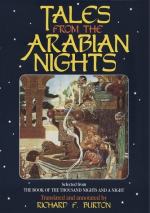[FN#23] It is not easy to explain this passage unless it be a garbled allustion to the steel-plate of the diamond-cutter. Nor can we account for the wide diffusion of this tale of perils unless to enhance the value of the gem. Diamonds occur in alluvial lands mostly open and comparatively level, as in India, the Brazil and the Cape. Archbishop Epiphanius of Salamis (ob. A.D. 403) tells this story about the jacinth or ruby (Epiphanii Opera, a Petaio, Coloniae 1682); and it was transferred to the diamond by Marco Polo (iii. 29, “of Eagles bring up diamonds”) and Nicolo de Conti, whose “mountain Albenigaras” must be Vijayanagar in the kingdom of Golconda. Major Rennel places the famous mines of Pauna or Purna in a mountain-tract of more than 200 miles square to the southwest of the Jumna. Al-Kazwini locates the “Chaos” in the “Valley of the Moon amongst the mountains of Serendib” (Ceylon); the Chinese tell the same tale in the campaigns of Hulaku; and it is known in Armenia. Col. Yule (M. P. ii. 349) suggests that all these are ramifications of the legend told by Herodotus concerning the Arabs and their cinnamon (iii. 3). But whence did Herodotus borrow the tale?
[FN#24] Sindbad correctly describes the primitive way of extracting camphor, a drug unknown to the Greeks and Romans, introduced by the Arabs and ruined in reputation by M. Raspail. The best Laurus Camphora grows in the Malay Peninsula, Sumatra and Borneo: although Marsden (Marco Polo) declares that the tree is not found South of the Equator. In the Calc. Edit. of two hundred Nights the camphor-island (or peninsula) is called “Al-Rihah” which is the Arab name for Jericho-town.
[FN#25] In Bul. Edit. Kazkazan: Calc. Karkaddan and others Karkand and Karkadan; the word being Persian, Karg or Kargadan; the {Greek letters} of AElian (Hist. Anim. xvi. 21). The length of the horn (greatly exaggerated) shows that the white species is meant; and it supplies only walking-sticks. Cups are made of the black horn (a bundle of fibres) which, like Venetian glass, sweat at the touch of poison. A section of the horn is supposed to show white lines in the figure of a man, and sundry likenesses of birds; but these I never saw. The rhinoceros gives splendid sport and the African is perhaps the most dangerous of noble game. It has served to explain away and abolish the unicorn among the Scientists of Europe. But Central Africa with one voice assures us that a horse-like animal with a single erectile horn on the forehead exists. The late Dr. Baikic, of Niger fame, thoroughly believed in it and those curious on the subject will read about Abu Karn (Father of a Horn) in Preface (pp. xvi.-xviii.) of the Voyage au Darfour, by Mohammed ibn Oman al-Tounsy (Al-Tunisi), Paris, Duprat, 1845.




